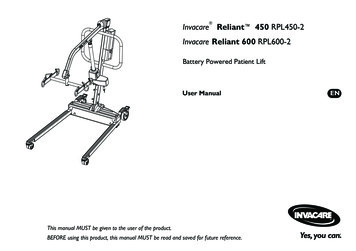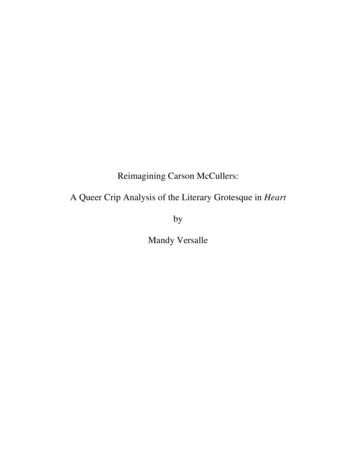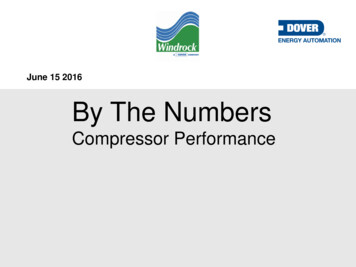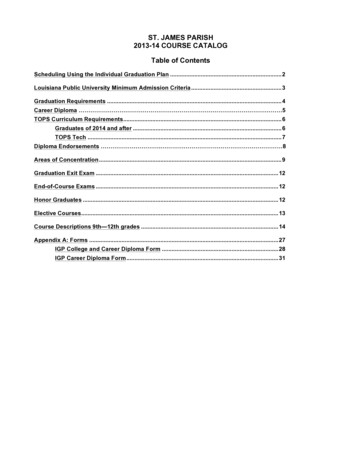
Transcription
PART 1PINCH AND MINIMUMUTILITY USAGE
WHAT IS THE PINCH? The pinch point is a temperature. Typically, it divides the temperature rangeinto two regions. Heating utility can be used only above thepinch and cooling utility only below it.
WHAT IS A PINCH DESIGN A heat exchanger network obtained usingthe pinch design method is a network whereno heat is transferred from a hot streamwhose temperature is above the pinch to acold stream whose temperature is below thepinch.
IS PINCH TECHNOLGYCURRENT? YES and NO. It is a good first approach to most problems. Pinch technology is at the root of many otherheat integration technologies. It is impossibleto understand them without the basic conceptsof pinch technology.
TEMPERATURE-ENTHALPY(T-H) DIAGRAMS Assume one heat exchanger. These nTTC,outTH, outTH, outTH,inTH, outSlopes are theTC,ininverse of F*Cp.Recall that Q F Cp TTC,outTC,inQQ H
T-H DIAGRAMS Assume one heat exchanger and a heaterTH,inTC,inQHQTC,outTH,inTTC,outTH, outTH, outTH,inTC,outTH, outTC,inHQHQTC,inQ HQH
T-H DIAGRAMS Assume one heat exchanger and a coolerTH,inTC,inTC,outQTH,inTTC,outQCTH, outTH,inCTH, outTH, outTC,inQCTC,outTC,inQQCQ H
T-H DIAGRAMS Two hot-one cold H2, outTC,inTC,outTC,inQ2Q1Q1 HQ2Notice the vertical arrangement of heat transfer
T-H DIAGRAMS Composite CurveObtained by lumping all the heat from different streams that areat the same interval of temperature.TT HRemark: By constructing the composite curve we loose information onthe vertical arrangement of heat transfer between streams H
T-H DIAGRAMS Moving composite curves horizontallyTTCoolingHeating HSmallest TTH1,inTC,inQ1TH2,inQ2TC,outTH1,out TH2,outSmallest TTC,in HTH1,inQ1QCTH2,inQ2QHTH2,outTH1,outTC,out
T-H DIAGRAMSTMoving the cold compositestream to the rightCooling HeatingSmallest TTC,inTH1,inQ1QC HTH2,inQ2QHTH2,outTH1,outTC,out Increases heating and cooling BYTHE SAME AMOUNTIncreases the smallest TDecreases the area neededA Q/(U* T )Notice that for this simpleexample the smallest Ttakes place in the end of thecold stream
T-H DIAGRAMST In general, the smallest Tcan take place anywhere.CoolingHeating We call the temperature atwhich this takes place THEPINCH. H
TEMPERATURE-ENTHALPYDIAGRAMSTCoolingHeating H From the energy pointof view it is thenconvenient to move thecold stream to the left. However, the area maybecome too large. To limit the area, weintroduce a minimumapproach Tmin
GRAPHICAL PROCEDURE Fix TminConstruct the hot and cold composite curveDraw the hot composite curve and leave it fixedDraw the cold composite curve in such a way thatthe smallest T Tmin The temperature at which T Tmin is the PINCH The non-overlap on the right is the MinimumHeating Utility and the non-overlap on the left is theMinimum Cooling Utility
HANDS ON EXERCISE H 27 MW H -30 MWREACTOR 2T 230 0CT 140 0C0T 200 C H 32 MW H -31.5 MWREACTOR 1T 20 0CTypeReactor 1 feedColdReactor 1 productT 40 0CT 250 0CT 180 0CStreamT 80 0CSupply TTarget T HF*Cp(oC)(oC)(MW)(MW oC-1)2018032.00.2Hot25040-31.50.15Reactor 2 feedCold14023027.00.3Reactor 1 productHot20080-30.00.25 Tmin 10 oC
Answer: Hot Streams200200p 0.FCFCp 0.2525015250pFC.4 0FCp 0.158040 FCp 0.15804031.530 H6487.5 H
Answer: Cold Streams230180F0.5 Cpp 0.2 0.2140FCFCp180140pCF230.30 .30p CF20203227 H242015 H
Answer: Both Curves Together.Pinch250230200180 T Tmin1408040201051.57.5 HImportant observation: The pinch is at the beginning of a cold stream or atthe beginning of a hot stream.
UTILITY COST vs. Tmin There is total overlap for some values of TminTCOST HUtilityTOTAL OVERLAPT Tmin HPARTIAL OVERLAPNote: There is a particular overlap that requires only cooling utility
PROBLEM TABLE Composite curves are inconvenient. Thusa method based on tables was developed. STEPS:1.2.3.4.Divide the temperature range into intervals andshift the cold temperature scaleMake a heat balance in each intervalCascade the heat surplus/deficit through theintervals.Add heat so that no deficit is cascaded
PROBLEM TABLE We now explain each step in detail.Consider the example 1.1StreamTypeSupply TTarget T HF*Cp(oC)(oC)(MW)(MW oC-1)Reactor 1 feedCold20180Reactor 1 productHot25040Reactor 2 feedCold140Reactor 2 productHot200 Tmin 10 oC32.00.2-31.50.1523027.00.380-30.00.25
PROBLEM TABLE1.Divide the temperature range into intervals and shift thecold temperature streamsColdstreamsHotstreamsColdstreamsNow one can make heat balances in each interval. Heat transfer withineach interval is feasible.
PROBLEM TABLE2.Make a heat balance in each interval. (We now turn intoa table format distorting the scale) Tinterval250 F Cp 0.15240200190F Cp 0.25150F Cp 0.3804030F Cp 0.2HotstreamsColdstreams HintervalSurplus/Deficit?101.5Surplus40- -2.0Deficit10- 2.0Deficit
PROBLEM TABLE3.Cascade the heat surplus through the intervals. That is,we transfer to the intervals below every surplus/deficit.1.5- 6.01.0-4.014.01.5This interval has asurplus. It shouldtransfer 1.5 tointerval 2.1.5The largest deficittransferred is -7.5.-4.5Thus, 7.5 MW ofheat need to beadded on top toprevent any deficitto be transferred tolower intervals- 6.01.0This interval has adeficit. After usingthe 1.5 cascaded ittransfers –4.5 tointerval 3.-3.5-4.0-7.514.06.5- 2.0-2.04.5-2.0- 2.02.5
PROBLEM TABLE4. Add heat so that no deficit is cascaded.7.51.51.59.01.5- 6.0- 12.04.5-2.0-2.02.5This is theposition of thepinch0.0-7.514.0This is theminimum heatingutility10.0This is theminimum coolingutility
IMPORTANT CONCLUSION7.5 λDO NOT TRANSFERHEAT ACROSS THEPINCH1.59.0 λ- 6.03. 0 λTHIS IS A GOLDEN RULE OF PINCHTECHNOLOGY.1.0 WE WILL SEE LATER HOW THIS ISRELAXED FOR DIFFERENTPURPOSES-4.0 WHEN THIS HAPPENS IN BADLYINTEGRATED PLANTS THERE AREHEAT EXCHANGERS WHERE SUCHTRANSFER ACROSS THE PINCHTAKES PLACEHeating utility islarger than theminimum4. 0 λHeat istransferredacross the pinch0. 0 λ14.014. 0 λ-2.012. 0 λ-2.010. 0 λCooling utility islarger by the sameamount
PROBLEM TABLEHeating utility of smaller temperature.0.07.51.51.5Heating utility atthe largesttemperature isnow zero.1.5 4.59.0- 6.0- 6.00.03.01.01.01.0 .0-2.0-2.010.010.0These are theminimum valuesof heating utilityneeded at eachtemperaturelevel.
MATHEMATICAL MODELδ0q1δ1q2Let q i be the surplus or demand of heat in interval i .It is given by:qi FHkcp kH (Ti 1 Ti ) k ΓiH FCscp sC (Ti 1 Ti )s ΓiCThe minimum heating utility is obtained by solvingthe following linear programming (LP) problemS min Min δ 0qiδiqi 1δi 1qnδns. tδ i δ i 1 q iδi 0 i 1,. mI
PART 2TOTAL AREA TARGETING
TOTAL AREA TARGETINGIn this part we will explore ways to predict the total area of a networkwithout the need to explore specific designs.Because A Q/(U* Tml), one can calculate the area easily in thefollowing situation.TTH1TC2TH2 Tml (TH1-TC2)-(TH2-TC1)lnTC1 HQ(TH1-TC2)(TH2-TC1)
TOTAL AREA TARGETINGSince area Q/(U Tml), the composite curve diagram provides oneway of estimating the total area involved. Isolate all regions with apair of straight line sections and calculate the area for each.THeating utility,steam or furnace.CoolingwaterA1 A2A3A4A5A6 HThe above scheme of heat transfer is called VERTICAL HEAT TRANSFER
EXERCISECalculate the values of Q in each interval and estimate thecorresponding area. Use U 0.001 MW m-2 oCTFurnace (300 oC)250230200180Pinch T Tmin14080CoolingWaterObtain the total4020area estimate HQ1 Q2Q3Q4Q5 Q6
EXERCISECOMPOSITE CURVE300Furnace(300 oC)250IT, C200PinchIIIIIIV150VVI100CoolingWater T Tmin50001020304050607080Q, MWHOTUnits:Q MWT oCA 14018020523090
200250300TH2408090150200250TC1TC2 430.881.9150.166.7778.41386.3243.391.6Total AreaUnits: Q MWT oCU 0.001 MW m-2 oC, A m22716.3
TOTAL AREA TARGETINGDrawbacks Fixed costs associated with the number of unitsare not considered.We will see later how the number of units can becalculated
QUESTIONS FOR DISCUSSION Is the total area predicted this way, realistic?That is, is it close enough to a value that onewould obtain in a final design? Is the estimate, realistic or not, conservative?That is, is it larger than the one expected from afinal design? How complex is a design built using the verticaltransfer?
ANSWERS Is the total area predicted this way, realistic?That is, is it close enough to a value that onewould obtain from a final design?YES, Within 10-15%
ANSWERS Is the estimate, realistic or not, conservative?That is, is it larger than the one expected froma final design?The area obtained is actually the minimumarea needed to perform the heat transfer.
ANSWERS How complex is a design built using thevertical transfer?Very Complex. Take for example interval 4.There are four streams in this interval.Stream(MWTypeSupply TTarget T(oC)oC-1) HF*Cp(oC)(MW)Reactor 1 feedCold1401808.00.2Reactor 1 productHot200150-7.50.15Reactor 2 feedCold14018012.00.3Reactor 1 productHot200150-12.50.25This implies at least three heat exchangers,just in this interval.
HEAT EXCHANGER NETWORK300408090150200 250 300FCp 0.09FCp 0.16R1 prod, FCp 0.15R2 prod, FCp 0.25FCp 0.1875R1 feed, FCp 0.2R2 feed, FCp 0.3FCp 0.1125I15IIIII203020IV140VVI180 205 230
HEAT EXCHANGER NETWORK408090150200 250 300300R1 prod, FCp 0.15FCp 0.16R2 prod, FCp 0.2520R1 feed, FCp 0.2FCp 0.075R2 feed, FCp 0.3FCp 0.1125I15IIIII2030IV140VVI180 205 230TOTAL 10 ExchangersCalled “Spaghetti” design
PREDICTING THE NUMBER OFUNITSWe can anticipate very simply how many exchangers we should have!!!Consider the following warehouses, each containing some merchandisethat needs to be delivered to the row of consumer centers. What is theminimum number of trucks needed?Warehouses30ConsumerCenters2550161756
ANSWERYou need five trucks, possibly less in some other cases. Here is howyou solve the problem specifically.305052525171116173956The general answer is N S-1 . When does one need less?
ANSWERWhen there is an exact balance between two streams or asubset of streams.25252555171616173956The general answer is N S-P . P is the number ofindependent subsystems. (Two in this case)
GENERAL FORMULA FORUNIT TARGETINGNmin (S-P)above pinch (S-P)below pinchIf we do not consider two separate problems, aboveand below the pinch we can get misleading results.
SUPERTARGETING Economy of the system is dependent on TminCOSTTotalUtilityCapitalOptimum Tmin
SPECIAL CASES There is total overlap for some values of TminTCOSTTotal HTOTALOVERLAPUtilityTCapital HPARTIAL OVERLAP TminNote: There is a particular overlap that requires only cooling utility
PART 3DESIGN OF MAXIMUMENERGY RECOVERYNETWORKS
MER NETWORKS Networks featuring minimum utility usageare called MAXIMUM ENERGYRECOVERY (MER) Networks.
PINCH DESIGN METHODRECALL THAT No heat is transferred through the pinch. This makes the region above the pinch aHEAT SINK region and the region belowthe pinch a HEAT SOURCE region.
Heat SinkHeat is obtained fromthe heating utility7.5Minimumheating 012.0H-2.0Heat SourceHeat is released tocooling utility10.0Minimumcooling utility
CONCLUSION One can analyze the two systems separately,that is, Heat exchangers will not contain heattransfer across the pinch.
PINCH MATCHES Consider two streams above the pinchTpTH,inTC,out Tp- Tmin Q/FCpCTH,in Tp Q/FCpHButTH,in TC,out Tmin.Thus replacing one obtainsQTC,out TminTp- TminFCpH FCpCQ/FCpH Q/FCpCGolden rule for pinchmatches above the pinch. TminViolation when FCpH FCpC
PINCH MATCHES Consider two streams below the pinchTpTH,outTC,in Tp- Tmin - Q/FCpCTH,out Tp-Q/FCpHButTH,out TC,in Tmin.Thus replacing one obtainsTp- TminQTC,in TminFCpC FCpHGolden rule for pinchmatches below the pinch. TminViolation when FCpC FCpH
CONCLUSION Since matches at the pinch need to satisfy these rules,one should start locating these matches first. Thus, ourfirst design rule:START BY MAKING PINCHMATCHES
QUESTION Once a match has been selected howmuch heat should be exchanged?
ANSWER As much as possible! This means that one of the streams has its dutysatisfied!!THIS IS CALLLED THETICK-OFF RULE
HANDS ON EXERCISE H 27 MW H -30 MWREACTOR 2T 230 0CT 140 0CT 200 H 32 MWT 80 0C H -31.5 MWREACTOR 1T 20 0CT 180Stream0CTypeReactor 1 feedColdReactor 1 productT 250 0C0CT 40 0CSupply TTarget T HF*Cp(oC)(oC)(MW)(MW oC-1)2018032.00.2Hot25040-31.50.15Reactor 2 feedCold14023027.00.3Reactor 1 productHot20080-30.00.25 Tmin 10 oCPINCH 150 oC
HANDS ON EXERCISEFCp 0.15H1250 0C40 0C150 0C200 0CFCp 0.2580 0CH2FCp 0.2FCp 0.3Stream140 0C180 0C20 0C230 0CTypeReactor 1 feedColdReactor 1 productC1C2Supply TTarget T HF*Cp(oC)(oC)(MW)(MW oC-1)2018032.00.2Hot25040-31.50.15Reactor 2 feedCold14023027.00.3Reactor 1 productHot20080-30.00.25 Tmin 10 oCPINCH 150 oC
ABOVE THE PINCHFCp 0.15H1FCp 0.25H2250 0C150 0C200 0C180 0CC1FCp 0.2FCp 0.3230 0C140 0C Which matches are possible?C2
ANSWER (above the pinch)FCp 0.15H1FCp 0.25H2FCp 0.2FCp 0.3250 0C150 0C200 0C180 0CC1230 0C140 0CC2 The rule is that FCpH FCpC . We therefore can onlymake the match H1-C1 and H2-C2.
ANSWER (above the pinch)FCp 0.15FCp 0.25H1H2250 0C200 0C180 0CFCp 0.2FCp 0.3150 0C203.3 0C230 0CC1181.7 0C812.5140 0CC2 The tick-off rule says that a maximum of 8 MW is exchangedin the match H1-C1 and as a result stream C1 reaches its targettemperature. Similarly 12.5 MW are exchanged in the other match and thestream H2 reaches the pinch temperature.
BELOW THE PINCHFCp 0.15H1FCp 0.25H2FCp 0.2150 0C40 0C80 0C140 0C20 0CC1 Which matches are possible?The rule is that FCpC FCpH . Thus, we canonly make the match H2-C1
ANSWER (below the pinch)FCp 0.15H1FCp 0.25H2FCp 0.240 0C150 0C80 0C52.5 0C140 0C20 0CC117.5 The tick-off rule says that a maximum of 17.5 MW isexchanged in the match H2-C1 and as a result stream H2reaches its target temperature.
COMPLETE NETWORKAFTER PINCH MATCHESFCp 0.15H1FCp 0.25H2250 0C40 0C80 0C200 0C140 0C180 0CFCp 0.2FCp 0.3150 0C203.3 0C52.5 0C20230 0C17.58181.7 0C140 0CC212.5 Streams with unfulfilled targets are colored.0CC1
WHAT TO DO NEXT?FCp 0.15H1FCp 0.25H2250 0C80 0C200 0C140 0C180 0CFCp 0.2FCp 0.340 0C150 0C203.3 0C52.5 0C20 0C2300C17.58181.7 0CC1140 0CC212.5 Away from the pinch, there is more flexibility to makematches, so the inequalities do not have to hold. The pinch design method leaves you now on your own!!!!! Therefore, use your judgment as of what matches to select!!
ANSWERFCp 0.15H1FCp 0.25H2250 0C80 0C200 0C140 0C180 0CFCp 0.2FCp 0.340 0C150 0C203.3 0C52.5 0C20230 0CC117.58181.7 0C0C140 0CC212.5 We first note that we will use heating above the pinch. Thusall hot streams need to reach their inlet temperature. We arethen forced to look for a match for H1. Please locate it.
ANSWER The match is H1-C1. We finally put a heater on thecold streamFCp 0.15H1FCp 0.25H2150 0C40 0C80 0C200 0C140 0C180 0CFCp 0.2FCp 0.3250 0C17.58230 0CH7.5140 0C712.552.5 0CC2C120 0C
ANSWER Below the pinch we try to have the cold streams start attheir inlet temperatures and we later locate coolers (one inthis case).FCp 0.15H1150 0C250 0CC40 0C10FCp 0.25H22000C80 0CFCp 0.2FCp 0.3140 0C180 0C230 0C8H7.5140 0C712.5C220 0C17.56.5C1
EXAMPLEFCp 0.15H1150 0C250 0C40 0CC10FCp 0.25H2200 0C80 0CFCp 0.2FCp 0.3140 0C180 0C230 0C8H7.514070CC220 0C17.5C16.512.5Nmin (S-P)above pinch (S-P)below pinch (5-1) (4-1) If we do not consider two separate problemsNmin (6-1) 5, which is wrong7Note: A heat exchanger network with 5 exchangers exists, but it is impractical andcostly. This is beyond the scope of this course.
UNEQUAL NUMBER OFSTREAMS AT THE PINCHIndeed, if the number of hot streams is larger than thenumber of cold streams, then no pinch matches arepossible.FCp 0.15H1FCp 0.25H2FCp 0.1Target 170 OCTarget 140 OCH3FCp 0.2FCp 0.4100 OC150 OC140 OC130 OC90 OC127.5 OC122.5C1OC7.5C2Assume the matches H1-C1 andthe matches H2-C2 have beenselected. Since H3 needs to go tothe pinch temperature, there is nocold stream left to match, even ifthere is portions of C1 or C2 thatare left for matching. Suchmatching would be infeasible.10What is then, the solution?
ANSWERSplit cold stream until the inequality is satisfied.FCp 0.15FCp 0.25FCp 0.1H1H2H3100 OC150 OC140 OC130 OC127.5 OCTarget 170 OCFCp 0.2Target 140 OCFCp 0.25130 OCFCp 0.15110 OC90 OCC17.5C2103Notice that different combinations of flowrates in the splitsatisfy the inequality.
INEQUALITY NOTSATISFIEDConsider the following case:FCp 0.5Target 170OCTarget 140 OCFCp 0.2FCp 0.4H1150 OC100 OC90 OCC1C2
ANSWERSplit the hot streamFCp 0.2H1150 OC100 OC140 OC90 OCFCp 0.3Target 170 OCFCp 0.2Target 140 OCFCp 0.4C110127.5 OCC215
SOLVE THE FOLLOWINGPROBLEMBelow the Pinch :FCp 0.5H1FCp 0.3H2FCp 0.7100 OCTarget 40 OCTarget 20 OC90 OC30 OCC1
ANSWERBelow the Pinch :FCp 0.5H1FCp 0.3H2FCp 0.5FCp 0.2100 OC40 OC6090 OC12Target 20 OCOC30 OC30Target 40 OCC1
COMPLETE PROCEDUREABOVE THE PINCHStartYesFCpH FCpCYesSH SCat pinch?NoNoSplit ColdStreamPlacematchesSplit HotStream
COMPLETE PROCEDUREBELOW THE PINCHStartYesFCpH FCpCat pinch?NoYesSH SCNoSplit HotStreamPlacematchesSplit ColdStream
HANDS ON EXERCISETypeSupply T(oC)Target T(oC)F*Cp(MW d2005500.02 Tmin 50 oCMinimum Heating Utility 9.2 MWMinimum Cooling Utility 6.4 MW
ANSWERFCp 0.04550 0C750 0CFCp 0.045358.89 0C350 0CH10.4FCp 0.04H2686.05 0CFCp 0.043FCp 0.029006400 0C300 0C0C550 0C8.689.2200 0C1500 0C6250 0CC1C2
TRANSSHIPMENT MODEL(Papoulias and Grossmann, 1983)δ0q1q2We will now expand the mathematical modelwe presented to calculate the minimum utility.δ1S min Min δ 0s. tδ i δ i 1 q iδi 0qiqi 1δiδi 1Whereqi HHFcp k k (Ti 1 Ti ) k ΓiHqδn i 1,. mICCFcp s s (Ti 1 Ti )s ΓiC
TRANSSHIPMENT MODELsi,k,1ri,1δi,1pk,1si,k,2ri,2pk,2Assume now that we do the same cascade foreach hot stream, while we do not cascade thecold streams at all. In addition we considerheat transfer from hot to cold streams in eachinterval.The material balances for hot streams are:si,k,jri,jδi,jpk,jsi,k,,j 1δ i ,0 0δ i , j δ i , j 1 ri , j si ,k , j j 1,.mIkri,j 1pk,j 1δi,j 1pk , j si ,k , jsi,k,nri,nδi,nThe material balances for cold streams are: j 1,.mIipk,nWhere ri,j and pk,j are the heat content of hotstream I and cold stream k in interval j.
TRANSSHIPMENT MODELsi,k,1ri,1δi,1pk,1si,k,2ri,2pk,2Although we have a simpler model to solve it,in this new framework, the minimum utilityproblem becomes:Min δ U , 0s.tsi,k,jri,jδi,jδ i ,0 0pk,jsi,k,,j 1ri,j 1pk,j 1 i, j 1,.mIδ i , j δ i , j 1 ri , j si ,k , j i, j 1,.mIpk , j si ,k , jk k , j 1,.mIiδi,j 1si,k,nri,nδi,npk,nNote that the set of hot streams now includesprocess streams and the utility U. Coldstreams include cooling water.
TRANSSHIPMENT i,jpk,jsi,k,,j 1ri,j 1pk,j 1ri,nδi,nThen we can force Yi,k to be one using thefollowing inequality si ,k , j ΓYi ,k 0jindicating therefore that heat has beentransferred from stream i to stream k in at leastone interval.δi,j 1si,k,nWe would like to have a model that would tellus the si,k,j such that the number of units isminimum. We now introduce a way of countingmatches between streams. Let Yi,k be a binaryvariable (can only take the value 0 or 1).pk,n
TRANSSHIPMENT MODELsi,k,1ri,1δi,1The complete model would be:pk,1si,k,2ri,2pk,2Min iYi ,kks.tsi,k,jri,jδi,jδ U ,0 δ U* , 0pk,jpk,j 1δi,j 1si,k,nri,nδi,n i, j 1,.mIδ i , j δ i , j 1 ri , j si ,k , j i, j 1,.mIsi,k,,j 1ri,j 1δ i ,0 0pk , j si ,k , j k k , j 1,.mIisi ,k , j ΓYi ,k 0 i, kjpk,nThe model can only be solved above andbelow the pinch separately. Why?
TRANSSHIPMENT MODELWe are minimizing the number of matches.Different answers can be obtained if separateregions are not considered. These answers arenot guaranteed to be realistic.
GAMS MODELMin iTABLE P(K,J)J0C10C20W0Yi ,kks.tδ U ,0 δ U* , 0δ i ,0 0 i, j 1,.mIδ i , j δ i , j 1 ri , j si ,k , j i, j 1,.mIpk , j si ,k , j k k , j 1,.mIload of cold stream K1 in interval JJ1 J2J38.6 6.45 2.15001006.4 ;VARIABLESS(I,K,J) heat exchanged hot and cold streamsD(I,J) heat of hot streams flowing between intervalsY(I,K) existence of matchZtotal number of matches ;isi ,k , j ΓYi ,k 0 i, kjGAMS MODELSETSI hot streams above pinch / S, H1 /K cold streams above pinch / C1,C2,W/J temperature intervals / J0*J3 / ;SCALAR GAMMA /10000/;TABLE R(I,J) load of hot stream I1 in interval KJ0 J1 J2J3S 9.2 000H1 0 0 6.75 2.25;POSITIVE VARIABLE SPOSITIVE VARIABLE DBINARY VARIABLE Y ;EQUATIONSMINMATCHobjective function-number of matchesHSBAL(I,J)heat balances of hot stream I in INTERVAL JCSBAL(K,J)heat balances of cold stream J1 in KHTINEQ1(I,K) heat transferred inequalities;MINMATCH . Z E SUM((I,K), Y(I,K));HSBAL(I,J) (ORD(J) NE 0) . D(I,J)-D(I,J-1) SUM(K,S(I,K,J)) E R(I,J);CSBAL(K,J) (ORD(J) NE 0) . SUM(I, S(I,K,J)) E P(K,J) ;HTINEQ1(I,K) . SUM(J, S(I,K,J))-GAMMA*Y(I,K) L 0 ;MODEL TSHIP /ALL/ ;SOLVE TSHIP USING MIP MINIMIZING Z;DISPLAY S.L, D.L, Y.L;
GAMS MODELSOLUTION---- VARIABLE S.LJ1J2S .C18.6000.600H1.C15.850H1.C2J32.1501.000---- VARIABLE D.LJ0J1J2SH10.9009.2001.0001.000750 0CFCp 0.045H1FCp 0.04H20.600---- VARIABLE Y.LC1C2SH1550 0CFCp 0.043900 0CFCp 0.02550 0C11.000EXECUTION TIME89.2 0.090 SECONDS500 0C
PART 4UTILITY PLACEMENTHEAT AND POWERINTEGRATION
UTILITY PLACEMENTWe now introduce the GRAND COMPOSITE CURVE, which will be useful toanalyze the placement of utilities.1.5TStart at the pinch- 6.02502401.0200190-4.0Pinch14-2.0150804030-2.0 H
GRAND COMPOSITE CURVETTotal heating utility250240200190These are called“pockets”150Process-to Processintegration takesplace here804030Total cooling utility H
UTILITY PLACEMENTWe now resort to a generic grand composite curve to show howutilities are placed.HP SteamTMP SteamLP SteamCooling Water H
Transshipment model for multiple utilities cMinm SmQmS cnQnWn Ws.tδ i ,0 0 i, j 1,.mIδ i , j δ i , j 1 ri , j si ,k , j Qi ,n , j i, j 1,.mIkδ m , j δ m , j 1 Qi ,n , j QmSm S i, j 1,.mIm Spk , j si ,k , j Qm ,k , j Qm SResultsm Sim ,k , j k , j 1,.mI QnW k , j 1,.mIHOT UTILITY 1 HP STEAMHOT UTILITY 2 MP STEAMIntervalT( i )Q( i )δ( i )HU1( i )I0I1I2I325020015030-4.5-3100004.5HU2( i )CU1( i )310HOT UTILITY 1HOT UTILITY 2COLD UTILITY
UTILITY PLACEMENTHot Oil placement and extreme return temperaturesHot oil fromfurnaceTOil minimum returntemperatureWater maximumreturn temperatureProcessCooling water H
UTILITY PLACEMENTFurnaceTheoretical FlameTemperatureTTstackAirTstackFuelAmbient TemperatureStack LossFuel heat value HProcessStream
COMBINED HEAT AND POWERIntegration of a Heat Engine below the Pinch.QH,minTTQHEPinchQHE -WQC,min ( QHE –W)W Note that in this casethere is no gain. The heatengine can be arrangedseparately and the utilityusage will not change.
COMBINED HEAT AND POWERIntegration of a Heat Engine Across the Pinch.QH,min -( QHE –W)TOTAL HENENERGY INTAKEQHEQH,min -( QHE –W)TWPinchQHE -W(Smaller)SYSTEM TOTALENERGY INTAKEQH,min Wvs.(separate)QC,minQH,min QHE
INTEGRATION WITHDISTILLATIONPlacement below the pinch.QH,minTIn this case there is again of (Qcond - Qreb)in the cooling utility.PinchQrebQcondQC,min (Qcond - Qreb)
HEAT PUMPS/REFRIGERATIONCYCLESTOTAL HEN INTAKEQH,min-(QHP W)QH,,min – (QHP W)(smaller)QHP WTOTAL SYSTEMINTAKEPinchWQHPQH,,min -QHPvs. QH,,min W (separate)Savings in cooling utilityQHPQC,min - QHP
COMBINED HEAT AND POWERUtility PlacementTQH,min –( QHP QLP)QHPQHEWQHPTQLPPinch QLPTOTAL HEN INTAKEQH,min –( QHP QLP)(smaller)QC,minTOTAL SYSTEM INTAKEQC,minQH,min Wvs. QH,min W (QHP QLP)(separate) H
COMBINED HEAT AND POWERGas Turbine PlacementTOTAL ENERGY INTAKETEXQH,min W QLOSSvs.QH,min W QLOSS QSTQFQH,min -QSTWAirPinchQSTEXT0QLOSSQLOSSQSQF -WQC,minT0 H
PART 5DISTILLATION PLACEMENT
PLACEMENT OF DISTILLATIONPlacement across the pinch.QH,min QrebTQrebPinchQcondQC,min QcondNote that in this case there isno gain. The distillationcolumn can be arrangedseparately and the utilityusage will not change.
PLACEMENT OF DISTILLATIONPlacement above the pinch.QH,min Qreb - QcondTQrebQcondNote that in this casethere is a possible gainin the heating utility.PinchQC,min
ADJUSTING PRESSURE FORPROPER PLACEMENTHeating UtilityTPinchTPinchPAs pressure increases utility usage decreases.
CRUDE FRACTIONATIONEXAMPLE We now show a complete analysis of an atmospheric crudefractionation unit. We start with the supply demand diagramCO NDENSERw a te rn a p h th aPA1ste a mPA2k erosen este a mPA3w a te rcru d eDESALTERd ie s e lste a mHENg a s o ilso u r w a te rste a mHENFURNACEr e s id u e
CRUDE FRACTIONATIONEXAMPLE We now show how to determine the heat load of pumparounds. We start with a column with no pumparound (results from arefrom a rigorous simulation)1.2PINCHM*Cp, ERATURE, C300400
CRUDE FRACTIONATIONEXAMPLE We move as much heat from the condenser to the firstpumparound as possible. The limit to this will be when aplate dries up. If the gap worsens to much, steam is added.1.4PINCHM*Cp, 0200TEMPERATURE , C300400
CRUDE FRACTIONATIONEXAMPLEWe continue in this fashion until the total utility reaches a minimum. .1.4PINCH1.2PA11.0M*Cp, MMW/ C 0.8CRUDE0.6COND0.4PA20.2RES00100200TEMPERATURE, C300400
CRUDE FRACTIONATIONEXAMPLEEspecially when moving heat from PA2 to PA3, steam usage increasesso that the flash point of products is correct and the gap is withinlimits.1.21.00.8PA10.6CRUDECOND0.41PA1M*Cp, MMW/C 0.2PA2PA3RES00100200TEMPERATURE, C300400
CRUDE FRACTIONATIONEXAMPLE Situation for a heavy crude0.8M*Cp, RATURE,300 C400
PART 6ENERGY RELAXEDNETWORKS
ENERGY RELAXATIONEnergy relaxation is a name coined for theprocedure of allowing the energy usage toincrease in exchange for at least one of thefollowing effects :a) a reduction in areab) a reduction in the number of heat exchangersc) a reduction in complexity (typically lesssplitting)
ENERGY RELAXATION IN THEPINCH DESIGN METHOD LOOP: A loop is a circuit through thenetwork that starts at one exchanger andends in the same exchanger PATH: A path is a circuit through thenetwork that starts at a heater and ends ata cooler
ENERGY RELAXATION Illustration of a LoopFCp 0.010H1125 0C175 0CC280FCp 0.040FCp 0.020H265 0C155 0CH360FCp 0.01520 0CC140 0CC21840500112 0C(*) Heat exchanger loads are in kW560520 Tmin 13 oC
ENERGY RELAXATION Illustration of a PathFCp 0.010H1125 0C175 0CC280FCp 0.040FCp 0.020FCp 0.015H265 0C155 0C20 0CH360C1184050040 0C112 0C(*) Heat exchanger loads are in kW560520C2
ENERGY RELAXATION Procedure : Find a loop and move around heat fromexchanger to exchanger until one exchanger is eliminated.125 0C175 0CH1C280H265 0C155 0C20 0CH360C11840 X500 -X11240 0C0C560 -XC2520 X If one wants to eliminate one exchanger: X 500. Note that Xcould have been negative, but we chose the smallest possible inabsolute value.
ENERGY RELAXATION Result: Notice that the result is infeasible!!!73 0CH1175 0CC65 0C45 0C28065 0CH265 0C155 0CH20 0CC140 0CC223403601120C601020108 0CThis exchanger is inviolation of theminimum approach
ENERGY RELAXATION We use a path to move heat around to restore feasibility73 0CH1175 0CC65 0C45 0C280 X65 0CH265 0C155 0C20 0CH360 X2340 -X112 0C40 0C60 XC1C21020 -X108 0CThe value of X needed to restore feasibility is X 795
ENERGY RELAXATION H1Final Network175 0CC65 0C45 0C107565 0CH265 0C155 0C20 0CH1155C115451120C40 0C85555 0C225C2
TEMPERATURE APPROACH ( T)RELAXATION We recall stating “NO HEAT ACROSS THE PINCH”. Being more specific, we should say, “NO NET HEAT ACROSSTHE PINCH”. Thus we allow the following situations.Pinchas long as the NET heat transferred across the pinch is zero.However this implies allowing the temperature difference to be lower than Tmin
T RELAXATION We thus define two types of Minimum Temperature Approach. HRAT: (Heat Recovery Approach Temperature): This is the Tmin we use to calculate minimum utility. EMAT: (Exchanger Minimum Approach Temperature): This isthe minimum approach we will allow in heat exchangers.When EMAT HRAT networks can have1. less splitting2. less number of units3. No significant increase in the total area.
T RELAXATIONConsider the following problemStreamTypeSupply TTarget T(oC)(oC)F*Cp(MW 0C2Cold401120.015We now consider HRAT 20 oC and EMAT 13 oC. Thecorresponding minimum utility are: TminHot UtilityCold Utility Pinch20 (HRAT)0.605 MW0.525 MW132 OC13 (EMAT)0.360 MW0.280 MW112 OC
PSEUDO-PINCH METHODWe now consider that the difference (245 kW 605kW-360 kW) needs to go across the pinch of a designmade using EMAT. Thus we first look at the solutionof the pinch design method (PDM) for Tmin 13 oCFCp 0.010H1125 0C175 0C45 0C280FCp 0.040FCp 0.020FCp 0.015H265 0C155 0C20 0C C1H36018405001120C40 0C560520(*) Heat exchanger loads are in
We now explain each step in detail. Consider the example 1.1 Stream Type Supply T Target T H F*Cp (oC) (oC) (MW) (MW oC-1) Reactor 1 feed Cold 20 180 32.0 0.2 Reactor 1 product Hot 250 40 -31.5 0.15 Reactor 2 feed Cold 140 230 27.0 0.3 .










